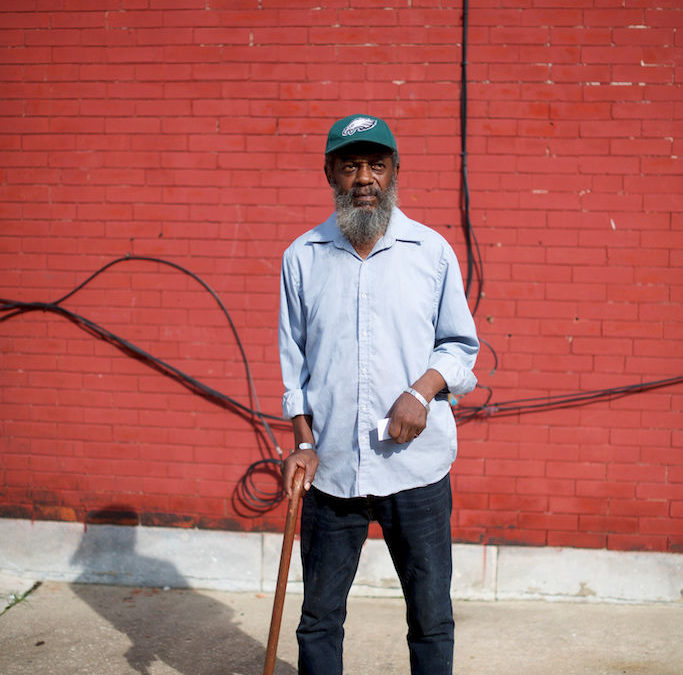Calvin Player had never heard of his section of West Philadelphia being designated as a Promise Zone despite having lived in Mantua for all of his 59 years.
But he’s been keenly watching all kinds of improvements to his neighborhood that the federal program set out to achieve when it was announced four years ago.
On a warm October afternoon, Player sat outside his apartment building on 35th and Fairmount Avenue and reflected on the changes – most of them good, he said – that he’s seen over nearly six decades as a resident of one of the city’s most poverty-stricken sections.
“This used to be the projects but they tore it down about 10 years ago and it made the neighborhood look a little better,” he said, sitting next to a patch of sidewalk garden where tomato plants were growing. “You can get anywhere in the city from here, it’s a marvelous place to live, you just need good people.”
The redevelopment of the block where Player, a retired carpenter, lives with his wife, Armetha Spearman, predates the Promise Zone designation in 2014 for the West Philadelphia neighborhood where half the population lived below the federal poverty line, and where measures of jobs, crime, housing and health painted a similar picture of a community that was struggling.
Almost half-way through its allotted 10-year timespan, the Promise Zone hasn’t yet made a big difference to many of those measures but has created links between the community, the City of Philadelphia and the federal government that didn’t exist before, and which are designed to lay the foundation for future progress.
Upgrades to housing like that where Player and Spearman live were among the goals set when the Obama administration selected Mantua, along with five other poor neighborhoods around the country, for the special assistance that would come with Promise Zone designation.
It also aimed to create jobs in a neighborhood where unemployment hovered at roughly 12 percent; build economic activity by helping small businesses; improve education so that young people would be better equipped to enter the workforce; curb violent crime, and attract private capital to an area that is close to Philadelphia’s downtown office hub.
The initiative was focused on areas where people lacked the resources and social supports to break out of a cycle of deep poverty, connecting them with quality education, good-paying jobs, affordable housing, and a safe place to live.
It would achieve its goals by helping residents acquire job skills, attracting public and private investment through improving access to finance, and improving security for small businesses. It also aimed to increase access to early childhood learning and build academic skills; reduce violent crime by increasing community policing, and work to attract more private investment.
“This initiative is focused in areas of deep poverty where people have lacked the resources and supports to break the cycle of poverty and join the middle class,” the federal government said at the time.
Nationwide, the other Promise Zone neighborhoods were in San Antonio, Los Angeles, southeastern Kentucky, and the Choctaw Nation of Oklahoma.
The program doesn’t offer direct infusions of federal cash but gives a community preferential access to services like identifying ways to obtain existing government investment, using grants to attract private real estate investment, and helping to find private money to invest in public housing.
Almost five years into the 10-year program, is it working in West Philly?
Early data on poverty, income, and some other measures of wellbeing stagnated or even deteriorated in the first two years of the program, reflecting the poverty rate for Philadelphia as a whole — which stuck stubbornly high at 25.7 percent in 2017, allowing the city to retain its status as the “poorest big city in America.”
In the Promise Zone, a roughly two-square-mile area that is home to about 30,000 people, the poverty rate in 2016 was almost twice the citywide rate, at 50.6 percent, up from 50.2 percent in 2014, according to the City of Philadelphia, citing data from the U.S. Census Bureau. The neighborhood’s deep poverty rate, defined as 50 percent below the federal poverty line, also increased – to 32.3 percent from 31.0 percent over the period.
The 2016 unemployment rate was little changed at 12.3 percent, more than twice the recent city-wide rate of 5.8 percent. Median household income in 2016 was $17,969, up slightly from $17,170 when the Promise Zone was announced. And the proportion of local people aged 25-64 with a high school education or higher edged up to 80.1 percent in 2016 from 79.6 percent two years earlier.
“The data [is] no surprise, and should not be taken to indicate that the Promise Zone isn’t working,” said Samantha Porter, Director of Place-Based Initiatives at the City of Philadelphia’s Office of Community Empowerment and Opportunity, and the City’s point person on the Promise Zone. She noted that the numbers are based on responses from only some people in the area just two years into the program, and do not accurately reflect changes since.
“We are four years into the designation, but in census data time, we are only two years in,” she said. “This is an inherent challenge, but the reason I think we need such a long designation in the first place.”
Under the federal Tax Cuts and Jobs Act of 2017, West Philly’s Promise Zone has also been designated an Opportunity Zone, one of 80 low-income neighborhoods in Philadelphia where new investors are eligible for tax breaks. Its status as an Opportunity Zone means it may attract additional investment, Porter said.
One of the challenges of the Promise Zone is to ensure that vigorous growth in adjoining areas such as University City – where expansion by the University of Pennsylvania, Drexel University, and private developers has sparked a construction boom — spills into surrounding neighborhoods, noted Porter.
“West Philadelphia is seeing a lot of growth, and that gives the impression that it’s equitable, she said. “There is still work to be done to ensure that growth is open to all of our neighbors.”
Even though the Promise Zone data suggests little progress, advocates argue that the program has facilitated a collaboration between government and community groups that didn’t exist before, ensuring at least that previously disparate groups are now pulling in the same direction.
“Groups in the area have collaborated in ways that we have not collaborated before, and that’s not for lack of trying, but through the Promise Zone initiative, it’s happening,” said James Wright, director of community, economic and real estate development at People’s Emergency Center, a Mantua-based nonprofit that provides social services including affordable housing, job training, and financial education.
“There are several nonprofits in Mantua, and before the Promise Zone, it was very hard to get us to work collectively,” he said. “With the Promise Zone, we communicate more regularly and with more goals and intent to produce something. From all the convening, people have this road map etched into their mindset on what boxes should be aligned to really help the neighborhood move forward.”
Wright said the collaboration fostered by the Promise Zone has also helped the neighborhood benefit from agreements with the developers of two major projects: the University City High School site and Schuylkill Yards, a $3.5 billion development of 14 acres of under-used real estate on the west side of the Schuylkill River. The developer of that project, Brandywine Realty Trust, agreed to provide $3.1 million over five years through a community benefits agreement aimed to provide small grants for community groups.
Wright believes that funding would not have happened without the Promise Zone. “That kind of collaboration would have been very difficult to pull off if we hadn’t had the kind of relationships that were developed through the Promise Zone community effort,” he said.
In their efforts to increase economic opportunity, officials have made it easier for small businesses in the Promise Zone to apply for loans. Rather than requiring them to fill out multiple loan applications, a consortium of 35 lenders have produced a single application that is designed to save time and hassle for small business people. Initiated for the Promise Zone, the idea has now spread citywide, said Karen Fegely, who heads the Neighborhood Business Services Unit in the City’s Commerce Department, and sits on the Promise Zone’s executive board.
“It’s really a challenge for small businesses to get financing,” Fegely said. “They have to go to a bunch of banks or community lenders and fill out a lot of ten-page applications. It’s very time consuming and very discouraging.” But the lending consortium has cut red tape and duplication, increasing the chances that borrowers will find the financing they need, she said.
Meanwhile, other sources of funding from donors such as the William Penn Foundation have continued to flow since the Promise Zone was set up but predated the initiative, and so can’t be attributed to it.
The Promise Zone hasn’t helped bring new federal money into the neighborhood; it doesn’t, for example, provide tax credits for a business that hires someone from the neighborhood. But it has made City agencies and community groups more aware of existing sources of funding, and helped some of them obtain it, Wright said.
Meanwhile, the initiative has helped community groups and relevant city-wide organizations set aside their individual agendas and work toward common goals, according to Porter.
On housing, for example, interest groups spent the first year and a half of the Promise Zone’s existence formulating a comprehensive plan that included disparate elements such as the number of vacant lots and the number of affordable housing units. Officials are now in a position to act on that, Porter said.
“It was a successful example of ‘how do all the partners come together and think about moving forward,’” she said. “Now, we’re working with the redevelopment authority, city council members and private developers on how we can start to put those recommendations into action. That’s the way we’re bridging the administrative or policy-focused work into real activity in the community.”
The Promise Zone’s housing goals have also been boosted by the involvement of Jumpstart, a nonprofit that trains community members in the skills of property development so that they can take control of local real estate before commercial developers move in.
From its base in Philadelphia’s Germantown section, Jumpstart is spreading to other neighborhoods including Mantua, where it has been schooling residents in skills like design and construction, financing and cost estimation so that they can become their own developers.
“That meets one of our objectives — affordability, ownership, remediation,” Porter said.
Homegrown development skills might allow the neighborhood to resist the gentrification that is bringing new construction and new residents to some areas of the traditional row-house landscape but also raising costs for existing residents, some said.
New apartment buildings are helping to boost real estate prices but simultaneously raising property taxes, said Ray Jackson, a longtime resident who was attending a street-corner barbecue for about a dozen people.
“The more they build, the higher your taxes get,” said, Jackson who has lived in the neighborhood for 55 years but had not heard of the Promise Zone. “It’s improving slowly but it’s not improving for the people in the neighborhood, just the people who come in to the neighborhood.”
The new arrivals include students from Drexel University whose main campus is just blocks away, and which has built new student housing on its campus in an effort to ease pressure on accommodation in surrounding neighborhoods like Mantua.
Edmund Chance, 72, said he too had never heard of the Promise Zone, and didn’t know whether the designation has helped improve the neighborhood since he bought a house there 15 years ago but said his property’s rising value suggests the area is finally turning around.
“It’s a whole lot better than it was a few years ago,” he said, standing next to an empty lot. “When I first came down here it was really rough. I bought a house down here cheap. I figured sooner or later it got to improve, and it did.”
Chance said the neighborhood still has a long way to go, especially on crime, which makes him wonder if it’s wise to go out at night, but that doesn’t stop him doing so. “I’m not going to let it keep me in,” he said.
Whether the neighborhood is beginning to turn around because of the federal designation or independently of it, some new construction contrasts sharply with the crumbling shells of abandoned buildings from another era.
On Haverford Avenue near 36th Street, a new three-story apartment house, hung with uplighters and an entry intercom, sits next to a derelict industrial building with its roof open to the sky and young trees growing out of fissures in its concrete. Next door, another blighted building is boarded up with graffiti-covered plywood, while across the street sits an artist’s studio covered with a multicolored riot of painted heads, hands and vegetation.
In an apparent effort to advertise its existence, the words “Promise Zone” are included in a mural painted on the side of the studio, bordering a grassed empty lot.
Even if the Promise Zone has nurtured the right conditions for Mantua to turn itself around, it has done so without the knowledge of residents like Chance and Player.
Only members of community organizations that have helped to implement the program seemed to be aware of it during a recent visit to the neighborhood. They included Sam Samuels, a member of the Mantua Civic Association, a nonprofit that advocates for safe streets, quality education, and affordable housing, among other issues.
Samuels, 50, said the community could have benefited from the initiative more than it has if community leaders had done a better job of publicizing it at the launch.
“Nobody knows what it is unless they come to our meetings and we explain what the Promise Zone is,” she said, standing on a neighborhood block. “You can put information out there but when the people don’t come to the meetings, they don’t get it.”
But Gwen Morris, 68, a retired teacher, defended the initiative, saying it had brightened the prospects for students at the Morton McMichael Public School for pre-K to eighth graders, across the street from Player’s apartment building.
The program provided grants and more resources to the school and resulted in its scores on standardized tests being “knocked out of the box,” said Morris, who now serves on the school advisory council. “The Promise Zone has done a really good job.”
TWITTER: @JONAHURDLE
This article is a joint collaboration with Spotlight on Poverty and is part of Broke in Philly, a collaborative reporting project among 21 news organizations, focused on Philadelphia’s push towards economic justice. Read more of our reporting at brokeinphilly.org.




